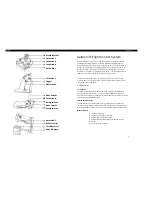
20
Automatic transfer switch (ATS)
EPCT FirE sEriEs FirE PumP ConTrollEr
MN124016EN August 2019 www.eaton.com
6.0 Automatic transfer switch (ATS)
6.1 General
Transfer switches are used to protect critical electrical loads
against loss of power. The load’s Source 1 power source is
backed up by a Source 2 power source. A transfer switch
is connected to both the Source 1 and Source 2 power
sources and supplies the load with power from one of the
two sources. In the event that power is lost from Source
1, the transfer switch transfers the load to the Source 2
power source. Once Source 1 power is restored the load is
automatically transferred back to the Source 1 power source.
The transfer switch will transfer to the backup source when
the Source 1 power falls below or rises above a pre-set
voltage, frequency, or in the event of a phase reversal. If
the Source 2 power source is a standby generator the ATS
will initiate a generator start up. It will then transfer to the
Source 2 power source once sufficient generator voltage
is available. When Source 1 power is restored the ATS
automatically transfers back to the Source 1 and will initiate
a generator engine shutdown.
The transfer switch has four basic elements:
1.
Main contacts
that connect and disconnect the load
from the Source 1 and Source 2 supplies.
2. The
ATS electrical control
circuit that energizes the
transfer mechanism to switch the main contacts.
3. The
mechanical transfer mechanism
that switches
the main contacts.
4. The
ATS control board and touchscreen display
that monitor the condition of the power sources and
provide intelligent decisions for the the operation of
the transfer switch.
6.2 Main contacts
The connection of the ATS load to either of the two source
supplies is managed through a pair of isolation switches.
The normal isolation switch controls Source 1 while the
emergency isolation switch controls Source 2. The mechanical
assembly that operates the isolation switches is designed to
prevent both sources from feeding the load at the same time.
The fire pump controller I/O board and the ATS control board
monitor the source 1 and source 2 voltages at the line side
of the isolation switches. A set of auxiliary switches installed
in each of the isolation switches provide positional feedback
to the ATS controller on which source is currently supplying
the load. These auxiliary switches are connected to terminal
68 (common), 70 (ATS Normal), and 71 (ATS Emergency). If
the ATS is in the Source 1 position then terminal 68 and 70
will be closed and 68 and 71 will be open. If the ATS is in the
Source 2 position then terminal 68 and 71 will be closed and
68 and 70 will be open.
6.3 ATS electrical control circuit
When the ATS control board initiates a transfer to Source
2 or Source 1 it will energize the 9CR relay located on
the ATS control board. Energizing this relay will result in
closure of the contact between terminals 72 & 73 on the
ATS board. Closing this contact will energize the ATS motor
and the motor brake. The motor is supplied power from
one of two 120Vac secondary control power transformers
supplied by Source 1 and Source 2. The control power
transformer primary voltage is derived from the line side of
the ATS isolation switches. The transformers provided in the
assembly will depend on the line voltage of the customer’s
application. To prevent the transformers from back feeding
one another a factory supplied relay (KV) is used to isolate
the transformers from each other. This KV relay will energize
whenever Source 2 is present.
6.4 Mechanical transfer mechanism
The smaller transfer switch controllers that use the
F-Frame (150A) isolation switches have the fire pump
controller and transfer switch located in the same
enclosure. The transfer switch portion of the controller is
separated from the rest of the fire pump controller using
a white, metal barrier. A beam mechanism connects the
isolation switch handles and the motor operator arm. The
beam attaches to a mounting plate at a pivot point located
between the isolation switches. The motor operator arm
rides in a track at the other end of the beam. As the motor
arm rotates the beam pivots on its mount causing the
normal and emergency isolation switch handles to move
up or down. This will connect or disconnect Source 1 and
2. At no time will both the normal and emergency sources
be connected at the same time. To manually rotate the
motor, you must first de-energize the controller. The motor
is located behind the operator arm on the mechanism
mounting plate. Locate the clutch plate on the bottom
of the motor towards the back of the enclosure. It is a
rectangular, gold coloured plate that has a small amount of
movement. Press and hold the clutch plate to the motor
frame. You will now be able to rotate the motor arm to
move the position of the beam.
The larger transfer switch controllers that use the K-Frame
(300A or 400A), L-Frame (600A), or N- Frame (800A or
1200A) isolation switches have the transfer switch located
in a separate enclosure. The separate enclosure is bolted
directly to the fire pump controller enclosure. The transfer
switch has a rotating metal handle and an arrow which
indicates the position of the transfer switch (normal/
emergency/neutral). The ATS motor operator mechanism is
located behind the manual operator handle and cover plate.
The motor operator mechanism connects to the handles of
the isolation switches. As the motor operator mechanism or
manual operation handle rotates the normal and emergency
isolation switches connect and disconnect. At no time will
both the normal and emergency sources be connected at
the same time. To manually operate the transfer switch, you
must first de-energize the controller. After it is de-energized
you may manually rotate the handle until the arrow aligns to
the desired transfer switch position.
















































